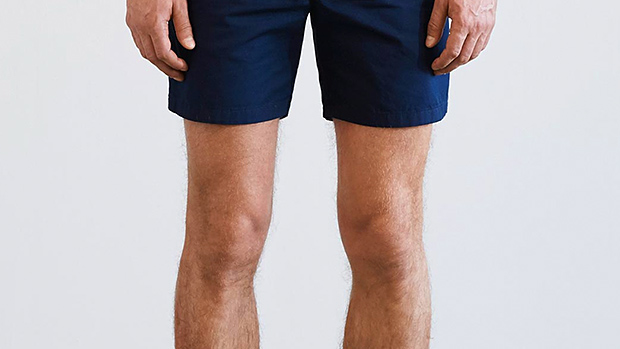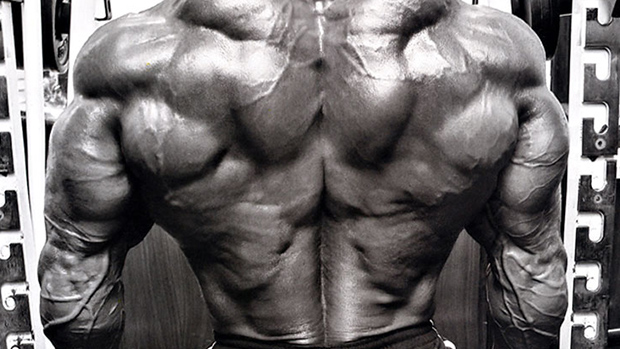I'm normally somewhat of a bookworm and science geek, although – to blow a little sunshine up my own butt – I have to say, I'm getting better at reading people.
T-Nation has been great for me in this regard. Your ordinary trainer might be exposed to 20 different clients in a week, and a typical collegiate strength coach might encounter 100 to 150 athletes over the course of a week. Like many others in this biz, I've been fortunate to experience both of those realms.
However, I do have a few legs up on my colleagues in this regard. I routinely get dozens of emails each day from readers, and have the opportunity to interact with the T-folk on our Author's Locker Room threads and at seminars. I can also chat with other coaches, trainers, writers, and therapists on a daily basis.
So, effectively, I get a broader pool of athletes, coaches, health care professionals, rehab patients, and ordinary weekend warriors from which to form my perspective on things. Sounds like a lead-in to my memoirs, huh?
Shut up and get to the point already!
Okay, you don't have to tell me twice. On the six-hour drive back from the D.C. T-Fest, I spent some time pondering who the typical T-Nation reader is. Hell, I'm writing articles for this typical lifter, so I might as well stop to consider what he really is.
After a few hours, it came to me: there is no "typical" T-Nation reader!
In fact, based on all the individuals I encountered in D.C., it was readily apparent that while all these folks had come to D.C. because they obviously wanted knowledge to help them achieve their goals, they all needed to be told different things – even in the broadest sense.
With that in mind, I came to identify six types of lifters that I see on a daily basis. Below, I'll describe them and offer some suggestions on how to get the ball rolling if you realize you're one of these lost individuals.
The "I'm Not Concerned with Strength" Guy
This one just has to go first.
There I was, sitting between two of the best strength athletes and coaches in the world, and it all came to a head. I almost lost it.
It had been said several times already over the course of the weekend seminar in D.C., and I had just shrugged it off each time, hoping it was just a slip of the tongue from some unsuspecting audience member. "Just give 'em a mulligan and move on," I'd tell myself.
There I sat on the end-of-the-day roundtable discussion with Dave Tate on my left and Dan John on my right. Both had just finished lively, entertaining presentations that absolutely blew the audience away. At the ripe ol' age of 24, I was feeling pretty damn honored to be sitting between these two guys. However, I wasn't too "star-struck" to overlook the abominable, yet nonchalant comment that was to follow from an audience member:
"I'm really only interested in size, not strength." To me, it was the spoken equivalent of a fart in church. As far as I could tell, many of the members of the roundtable shared my distaste for the statement.
Alwyn Cosgrove buried his head in his hands and muttered something about ancient Scottish execution traditions. Anthony Roberts set down his beer and pondered the fate of the universe. Joel Marion wiggled uneasily in his chair. Dave Barr almost choked on the three Pop Tarts he had stuffed in his mouth. Dan John stared off into space in disbelief, and I could practically feel the steam coming out of Dave Tate's ears. Dr. Ryan Smith even lost neutral spine for a second and sunk into a position of dangerous lumbar flexion. The entire panel was "quietly" up in arms.
 |
I'm the guy in the white shirt on the far right whose daydreams about deadlifts were just interrupted by the sudden urge to vomit in my mouth.
How could the guy who made this statement not see that size and strength are intimately related? Have we not done a good job of relating that over the past eight years at T-Nation? Even if size and strength weren't related, how could anyone not care about strength? I don't care whether you're deadlifting 700 pounds or carrying a bag of groceries, it's fun and functional to be strong.
I could've jumped right up and given him a sermon on how a lack of maximal strength will have a ceiling effect on other motor qualities; about how power and strength endurance will peak without maximal strength; about how you can't expect to be progressively more successful in traditional hypertrophy training zones without training them with heavier loads over time.
Call it whatever you want: resistance training or weight training; in both cases, the first word implies that you actually have to put some damn weight on the bar. For reasons that are beyond my comprehension, I kept my yapper shut at the time.
Some Recommendations for the "I'm Not Concerned with Strength" Guy: Shit or get off the pot, dude! We're lifting heavy things here! Stop measuring the effectiveness of a session by how much blood is in your biceps, and more by how much weight is on the bar as compared to the last session.
Set up an Excel spreadsheet on your hard drive. Pick eight lifts: four upper body, four lower body. Put down your 1RM on each of those movements. Do everything in your power to add 10% to each of those lifts over the course of six months. Get stronger and you'll be amazed at what happens to your body. You might even put on some of that size you covet so much!
The "Too Much, Too Soon" Guy
This is the guy who veterans should all love to help. He's enthusiastic about lifting and really wants to learn everything there is to know about training. Unfortunately, he also wants to try everything, usually all at once! One or more of four things happens:
1. He overtrains and winds up feeling like absolute crap all the time. In the process, he begins to assume that this is how lifting is supposed to make you feel, and writes it off forever. Basically, he burns out on something he never understood.
2. He starts off with bad lifting technique habits because he hasn't established a foundation for safe form. He might have a weak core, tightness in his hips, and no frontal plane stability, leaving him squatting with a rounded back and knocked knees. He either establishes bad habits that'll be difficult to break down the road (if he breaks them at all), or he winds up getting hurt. Either way, he's off to a bad start.
3. He piles too much weight on the bar or does too much volume, and winds up with a traumatic or overuse injury.
4. He makes good gains with some volume, and immediately assumes that more volume will equate to more gains. This might be the case as a newbie, but it's a bad impression to have going into the intermediate and advanced stages of your training career.
Some Recommendations for the "Too Much, Too Soon" Guy: Your enthusiasm is admirable; don't lose it! However, do lose the quick-fix mindset and learn to love the process as much as the destination.
Find a good lifting crew or more experienced training partner to watch over you as you get started. Post often on forums where there are a lot of experienced lifters. Show that enthusiasm and a willingness to learn, and always thank them for their advice. If you do so, they'll almost always point you in the right direction.
Also, remember that just because you can lift a weight on a given day doesn't mean you should lift it on that day. Rest is as important as training, and you need to know when to take back-off weeks. Lastly, form always comes first; lift in good technique and the weight will come.
The "One Step Forward, One Step Back with Injuries" Guy
I've always felt that maximal strength is a lifter's single most precious commodity. However, one flaw in my logic was that there's one thing that's completely foundational to being strong: your health.
We've all been down the injury road, so it's fair to say that we've all been in this category at least once in our training careers. I can't tell you how often I get emails from people saying that they were making incredible progress with their bench press or squat until they got hurt, and now they're back to square one.
In the context of this classification, the factors that separate frustrated lifters from successful lifters who "escape" from this category in the long-term are:
1. The ability to recognize the injury immediately and take an appropriate course of action. "Train through it" isn't an option unless you're a really big time athlete on the brink of a really big time competition/game. Curt Schilling in the 2004 ALCS would be a good example.
 |
I just had to take a shot at Yankees fans.
Short-term therapeutic modalities include soft tissue treatments (e.g. ART, massage), ultrasound, cryotherapy, compressive wraps, and the abhorred rest.
2. The ability to understand how to train around the injury in order to avoid detraining during the downtime you must take.
3. A knowledge of how dietary and supplemental factors influence recovery. Just because you're hurt doesn't mean you should be comforting yourself with an entire gallon of ice cream.
4. An appropriate progression when the time comes to return to lifting. For example, when someone is coming back from external impingement and wants to bench again, I use the following progression:
Body Weight Push-up Isometric Holds > Body Weight Push-up > Weighted Push-up > Cable Crossover from Low Pulley > Cable Crossover from Hip Height > Neutral Grip DB Floor Press > Neutral Grip Decline DB Press > Pronated Grip Decline DB Press > Barbell Board Press (gradual lowering) > Decline Barbell Press > Flat DB Press > Incline DB Press > Barbell Bench Press > Barbell Incline Press
Basically, I know that I want to go in the order of:
• Closed-chain (e.g. push-up) before open-chain (e.g. bench press).
• Arms below shoulder level before arms at and above shoulder level.
• Traction (pulling the humeral head away from the socket, as with a cable crossover) before approximation (forcing the humeral head into the fossa, as with a bench press).
• Dumbbells (allows freedom of motion in humeral rotation) before barbells.
• Isometrics and long eccentrics before "regular" speed movements.
All the while, the individual would still be addressing all the factors that led to the injury in the first place. In this case, I'd be looking to continue strengthening the scapular retractors and depressors and the humeral external rotators.
He'd also continue range of motion and soft-tissue work on the upper traps, levator scapulae, pecs, lats, anterior delts, subscapularis, and teres major while paying close attention to his posture. I'd recommend icing after exercise and ART as often as possible to get that shoulder back on track. Obviously, this is just one example, but it should give you a picture of the thought process that should go into returning from an injury.
5. A fundamental knowledge of how to prevent recurrence of the injury.
 |
Now here's a guy who could've used Eric's help rehabbing.
So, with these five considerations in mind, how are you going to avoid becoming one of the frustrated ones?
Some Recommendations for the "One Step Forward, One Step Back with Injuries" Guy: First, you need to take care of your soft tissues. It's important to address soft tissue quality with soft-tissue treatments like ART and foam rolling , and then address soft tissue length. Dynamic joint range of motion ("active length" that's neurally mediated) should be addressed with dynamic flexibility/mobility training, while passive flexibility ("feel good" range of motion that's particularly good in rehabilitation) can be addressed with static stretching.
Second, you need to keep the diet clean during recovery. Increase your intake of healthy fats, keep overall calories high enough to facilitate healing, and don't indulge in junk carbs.
Third, take back-off weeks in your training. It's impossible to go full throttle year-round; many injuries are simply the result of tissues "giving in" to a chronic stress. If they're given a break, they have time to adapt and come back stronger. If you hammer on them mercilessly, you just continue to make them more susceptible to injury. Your nervous system will thank you, too.
Fourth, warm up properly before training. You can kill two birds with one stone and get your warm-up and dynamic flexibility work in simultaneously with the drills outlined in Magnificent Mobility.
Fifth, train with structural balance. To keep this discussion very simple, balance all your pushes with pulls, and then add in a bunch of rows, external rotations, and single-leg exercises.
Sixth, know the limits of your knowledge. If you don't understand how the human body works, seek out the help of a qualified professional to help you design a "return to action" plan. Trust me, it'll be worth the money in the long-run!
The "No Goal" Guy
The word "training" implies that you're preparing for something. If you don't have something for which to prepare, you're really just working out – and that doesn't distinguish you much from the housewife on the abductor machine next to you.
Sure, you probably look better in shorts than she does, but at the end of the session, you're both just one hour closer to dying. When I leave the gym, I know I'm one hour closer to an elite total. Just some food for thought.
 |
 |
| This Guy "Works Out" | This Guy "Trained" |
Some Recommendations for the "No Goal" Guy: I can't tell you what your goal is supposed to be, but you need to decide on one. It might be powerlifting, bodybuilding, strongman, intramural soccer, or pocket pool. Whatever it may be, put it in writing and tack it up somewhere you know you'll see it every day. Here's the dry erase board on my refrigerator reminding me of the squat-bench-deadlift number I need for Elite in my next meet.
 |
I've seen this each time I've walked past the fridge since November... and I eat a lot.
I also get a reminder with every lift at South Side when I look up at my previous best total that's on the record board. You can't plan for something if you don't have a goal!
The "No Plan" Guy
Often, this is someone who has progressed from being a "No Goal" Guy to having a goal, but not determining an appropriate course of action to achieve it. Conversely, it's not uncommon for the "No Plan" Guy to be in this situation because he really doesn't know exactly what he needs to do to get from Point A to Point B.
I've always said that the toughest person for whom to write programs is oneself. There's a natural tendency to prioritize your favorite lifts instead of those you need the most, and you can never get an accurate assessment of where you're erring in your ways when you're lifting.
Some Recommendations for the "No Plan" Guy: If you think you know what you need to do, write it down and do it. You might also consider bouncing it off someone whose opinion you value with respect to training, nutrition, and supplementation.
If you haven't the slightest idea what to do, you've got several options. As noted above, find someone with whom you've trained to throw some ideas your way. Post some thoughts on the forum here at T-Nation to get feedback from others. Read up on what others have done before you set out to accomplish the same goals.
You'd be wise to find a good training partner or crew to help you brainstorm a plan and put it into action. If that's not feasible, consider online coaching with someone who can tell you what to do and how to do it. It's generally cheaper than even a few sessions per month with your local bonehead personal trainer.
The "No Attitude" Guy
Entire articles have been devoted to this topic, but the truth is that most people who don't have attitude already know that this is their problem! The secret rests with finding something that will light a fire under this guy's ass as he steps into the squat rack – if he ever makes it there in the first place.
Some Recommendations for the "No Attitude" Guy: First up, find a good training partner. Make sure that he's completely devoted and preferably strong, experienced, and butt-ugly (you won't find many "pretty" guys who are strong).
Second, find a hardcore gym that allows chalk and plays loud, belligerent, "my mother didn't love me" music. Powerlifting gyms are great for this purpose – even if you aren't a powerlifter per se. You can find a decent, but certainly not extensive, list of suitable U.S. gyms HERE.
 |
Likewise, the guys over at Elitefts.com will always help you find some good training partners if you're looking to get into the sport. Just throw a post up on their forums and they'll help to get you on track. Or, you can simply throw an inquiry up on the forums here at T-Nation. You'll be surprised at how many small, hardcore, dungeon-like gyms can be found not too far from where you live.
Third (and this piggybacks on my last recommendation), find a good training crew. If they won't toughen you up, nothing will.
Fourth, figure out what music it is that fires you up, and make sure that you have that music playing on the ride to the gym and once you get to the gym.
Fifth, go rent Braveheart and Gladiator and eat some red meat.
A Brief Word in Closing
Don't get me wrong, I don't feel that everyone falls into one of these categories. There are plenty of people out there who really have it together, and others who falter for reasons other than the ones I mentioned. This is just my observation of the most common problems.
I'm certainly interested in hearing T-Nation's opinion on what other "types" need to be included in this discussion. I encourage you to throw out some ideas in the replies to this article. It sounds corny, but the more we know, the more we grow!




